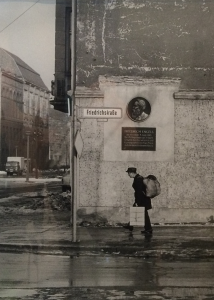
Klemm displays German history in her intriguing “Light and Dark” display.
Pictures in the newspaper every day serve as useful additions to the articles featured next to them. However, when saved over the course of several decades, such pictures can collectively provide a documentation of history as it occurred. The Goethe-Institut’s latest featured exhibit, “Light and Dark,” does just that. It has an assembly of 25 photos taken by Barbara Klemm during and after the separation of East and West Germany, most of which were originally taken to be used in the daily newspaper, Frankfurter Allgemeine Zeitung. All the photos are black and white.
The Goethe-Institut will be showing “Light and Dark” through Friday, Feb. 27, 2015, but is only open Monday through Friday, so make sure not to go on a weekend. The museum itself provides a very interesting setting for this exhibit, as viewers will likely hear the staff members talking to each other in German in the background while looking at these photos that represent the country’s history.
Klemm is one of the most distinguished female photographers from Germany. To quote the exhibit’s description, “Many of her pictures have become ‘icons of contemporary,’ shaping the cultural memory of several generations.” As a commissioned newspaper photographer, she had the chance to witness several of the most important events in Germany and numerous other countries surrounding the Iron Curtain in the Cold War era. For example, the Goethe-Institut’s lobby also has a feature on some of her photos from Georgia, which are part of a different exhibit.
The theme of the photos in “Light and Dark” is strictly Germany before and after its reunification. They are intended to depict all aspects of German society — from politics to culture to everyday life, showing historic protests as well as regular people doing daily tasks. Nevertheless, the political aspect is most prevalent — even the photos of common people on a day-to-day basis contain clear political messages. These political undertones make sense since the photos initially accompanied newspaper articles that probably discussed the latest national crisis.
However, the progression of events that Klemm reveals is fascinating. She evidently assembled this set of photos several decades after the fact with a specific concept in mind, but the emotions captured in the photos feel as real as ever. One frequent message in the photos — from empty streets to fierce protests to brutal soldiers — is that of chaos and uncertainty during Germany’s tumultuous split.
The photos taken after Germany’s reunification represent a different mood. People’s facial expressions show happiness and hope, and instead of mass protests, viewers can see large cheers.
One of the more interesting photos is titled “Fraternal Kiss between Leonid Brezhnev and Erich Honecker, Marking Thirty Years of East Germany.” It depicts two grown men in suits (seemingly politicians) smooching as they embrace one another in front of a group of similarly dressed, but laughing, onlookers. This kiss is actually a Russian Orthodox ritual that became popular during the Communist movement and apparently represents Jesus Christ, according to the photo’s description. Male Communist leaders in the Eastern Bloc practiced this kiss regularly, and their critics labeled it as the “kiss of Judas.”
Another interesting photo is the most recent in the exhibit and the only one taken since the turn of the century. It is called “Angela Merkel, Reto Francioni, Deutsche Börse,” which Klemm took at the German Stock Exchange in Frankfurt in 2008. Merkel grew up in East Germany prior to the 1990s unification, but she became chancellor in 2005 in a coalition of the two largest political parties, the CDU and SPD. As the current head of state, Merkel stands out in this exhibit from other historic figures such as Gorbachev and Reagan since she represents the modern era. Nevertheless, Klemm’s inclusion of this photo continues the theme of Germany’s unification since the leader of modernized Germany actually lived on the east side of the Berlin Wall.
Most of the photos do not carry such positive messages, though. For example, “Friedrichtrasse” shows a lone man walking by a bleak street corner in East Berlin in 1970. In “Ronald Reagan Visits,” four soldiers brutally attack a peace protestor in the street, as Reagan’s demands to bring down the wall prompted protests against NATO policy, which led to riots and a brutal police response.
From the chaos of separation to the triumphant rebuilding of a united Germany, Klemm’s photos carry viewers both through this storied period in German history and her own experience of capturing such important moments. One can see empty streets, passionate rallies, famous world leaders, important resurrected buildings and almost everything in between.
For history, photo or culture enthusiasts, “Light and Dark” provides a very fascinating first-hand account of the real time events surrounding the German Cold War era that would be hard to find anywhere else. In the low-key and authentic setting of the Goethe-Institut, viewers can relive these four decades in just a few minutes. But with less than a month remaining and openings only on weekdays, not much time is left!


















